Best Solar Generator for RV, Camper, & Motorhome 2024
If you want to know what the best solar generator RV that is lightweight and compact, can run anything, has a fast charging speed, good power output, and check out our article.
Having been associated with the RV industry for 12 hours now, and being an outdoorsman, I am witnessing a bloom in the power station industry. A lot of people are switching to portable solar power generators for RV instead of battling with the complex installation of lithium batteries and loads of solar panels.
Travelers seek a portable, compact, and lightweight one-stop for all types of solutions that can cover their daily life energy needs.
I have spent 24 days in research, tested 17 units, interviewed 3 professionals who are currently working in different power station manufacturing companies, and talked to 42 RVers and outdoorsmen to select the Top 5 solar-powered RV generators within the affordable price tag.
Stick around and read the complete article, maybe it will help in your outdoor journey.
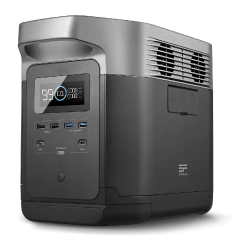
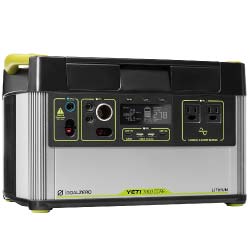
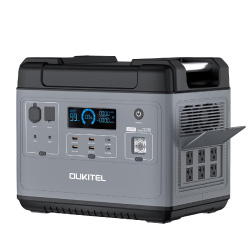
1. Ecoflow Delta 1300 – Best Solar Generator for RV Camping
FEATURES & SPECS

Ecoflow Delta 1300 is slightly on the portable side which is always a good thing for RV or travel trailer users.
It is one of the most popular and positively reviewed portable solar-powered generators for RV that can easily a small fridge, a 13,500 BTU AC, LED lights, laptops, cellphones, coffee makers, an oven, and other appliances with its whopping 1800 running watts, and 3300 surge watts, and a massive 1260Wh battery.
One of the main selling points for me was the X-stream fast charging technology which comes in handy.
A variety of AC and DC ports are also appreciable if you want to run different appliances on the road.
Delta 1300 solar generator features one of the best BMS on the market. It doesn’t eat any extra charging just to stay ON which is a big plus.
I like the compact and portable design as well. It weighs 30.9 pounds which is not huge for a 1260Wh solar generator. With its low center of gravity, it doesn’t need support to stand still. I can easily put it in the back of my truck.
It features the following ports.
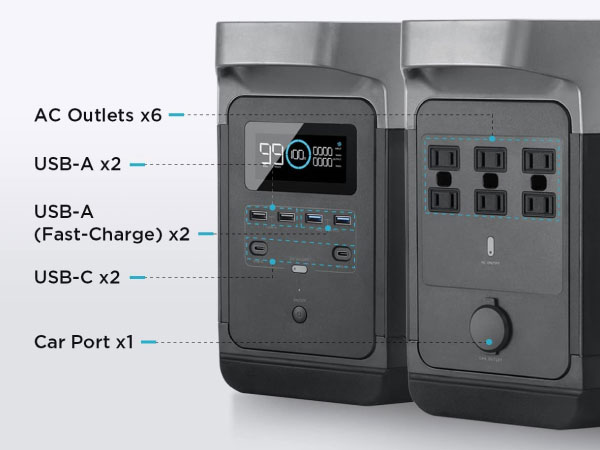
- X6 AC outlets.
- X2 USB-A outlets.
- X2 fast charging ports
- X2 USB-C outlets (60W)
- DC 13.6V port
I loved the LCD on the front control panel. Instead of telling percentage, it tells how many minutes and hours are left on the device which gives a lot of clarity. It also tells battery stats, incoming and outgoing power, and error codes.
There are three ways you can charge this portable power station. Solar, AC wall outlet, and Car outlet.
Using 400W solar input, the device took only 7.1 hours to completely charge using Rockpal SP003 100W solar panels.
I was a little disappointed with only 400W solar input for a 1800W solar generator. Ecoflow should improve the input solar to 700 or 800W. It will increase the charging speed.
Delta 1300 features X-stream fast charging technology. Through the AC wall outlet, it takes less than an hour to charge from 0 – 80%. From 0 – 100%, it takes 1 hour and 40 minutes. I have tested this many times.
You can purchase this unit for its charging prowess alone.
Using a 12V DC car port, Delta 1300 takes 14 hours to fully charge. I normally use and charge this unit whenever I go on a camping trip to the woods. I charge my drone and camera batteries and power a mini-cooler off of it during the drive.
Ecoflow Delta 1300 will be able to run the following devices according to my tests.
- 60w Laptop: 23 hours. 32 charges
- Power saver light: 37 hours
- 600w Coffee maker: 55 cups
- 120W Freezer: 10 to 17 hours
- 1600 Hair dryer: 1 to 3 hours
- 110W TV: 7 to 8 hours
- 500W blender: 2 to 2.5 hours
- 65W projector: 11 to 13 hours
I conducted a little Load Test on 3 different occasions after using it for 6 months.
- Load of 1790 watts and the power station didn’t shut off.
- I increased the load to 1810 watts, and the device was still ON.
- Increased the load to 1830 watts and then finally, the overload alarm went ON.
I have taken Ecoflow Delta pro with me in my RV many times as a backup power source during night camping, I have been able to run everything I want it to run without any problem.
The battery doesn’t drain easily, and the huge capacity allows me to my power my 13,500 BTU AC when I am stationary. I believe this is a perfect unit for an RV.
The shelf life is around 12 months with 800+ cycles.
The only complaint I have is the arrangement of the ports. The inputs and USBs are on opposite sides. Forget about putting it in the corner. It messes up the cable arrangement.
Here is the full review of Ecoflow Delta 1300
2. Goal Zero Yeti 1000 Portable Solar Generator for RV
FEATURES & SPECS

Goal Zero Yeti 1000 may not be the most powerful power station on the list, but due to its reliable performance and many DC outlets, it is considered a fantastic unit for RVs and Camping.
I take a lot of videography equipment with you in your RV like me, you will be able to charge most of them off of this little beast thanks to its 1200 rated watts, 2400 surge watts, and 983Wh battery capacity.
Compared to Goal zero 1000x which has a 1500W inverter, goal zero 1000 has a 1200W inverter. Other than that, both are identical.
Its design is compact and portable with a flat top with a low center of gravity. Your charger and cables will go into the hidden door at the top to save space.
The casing is made of rugged aluminum which makes it prone to wear and tear on the road.
Goal Zero 1000 features the following ports on the front panel:
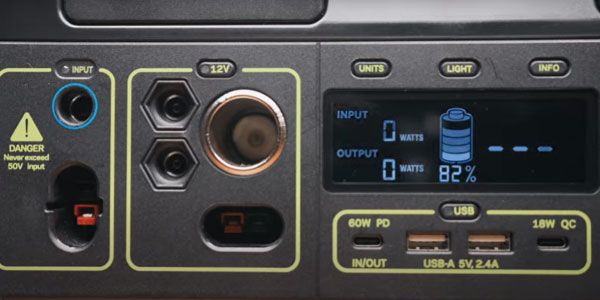
- X2 USB-A ports (output): 5V, 2.4A, 12W max.
- X1 USB-C port: (output): 5 to 12V, 3.0 18 max.
- X1 USB-C PD 60W fast charging port (input/output): 5 to 20V, 3.0A, 60W max.
- X2 120V AC ports (output, since wave): 60HZ, 120VAC, 10A
- X1 regulated 12V port: 12V, 15A, (180W)
- X3 6mm ports (output): 50 20V, 3.0A, 60 max)
Like other top-of-the-line solar generators for RV, Goal zero 1000 also has 3 charging options. Solar, wall, and 12V car charging.
It can accept a maximum of 300W and the device takes about 4 to 4.3 hours to completely charge. I normally use Nomad 100W solar panels with this unit.
My complaint is 300W is a bit low for a 1200W solar generator, I hope they improve it in the future.
It takes about 120W AC from the wall outlet. The device takes around 8.9 to 9 hours to charge completely.
From the 12V car input, it will take around 9.1 to 9.2 hours to fully charge.
You will be able to run the following devices off of Goal Zero Yeti 1000.
- Fridge: 15 to 18 hours
- Laptop: 17 to 20 hours
- Camera: 50 to 55 hours
- Drone: 15 to 17 hours
- Electric grill: 14 to 16 hours
- Drill: 12 to 14 hours
Here is the full review of Goal Zero Yeti 1000
3. Rockpals 600W Portable Solar Generator for RV
FEATURES & SPECS
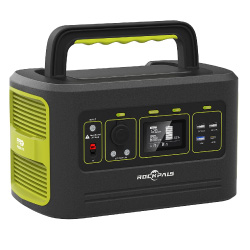
Rockpals 600W is one of the most compact and lightweight solar-powered Rv generators currently available in the market. This thing is very sleek with a 614Wh capacity.
It is 12V regulated and provides 600 running watts and 1000 peak watts with 3000+ cycles thanks to the LIFEPO4 battery composition.
I believe Rockpals 600W is a direct competitor of Jackery in terms of design. The only difference I can spot is the collapsible handle which makes the surface flat and makes it even more compact and portable.
I am also impressed by the built quality as well. It is made of 1200D high-density material which not makes it super strong, but moisture-proof as well. I have used it outdoors in foggy conditions without any problem.
Another selling point for me was the high-quality BMS. Based on my tests, the BMS on this power station is more efficient than Bluetti.
I once took ROCKPALS 600W on a camping trip with me in my RV. I was only powering a mini-cooler, a navigation device, a drone, a laptop, and some LED lights off of it. Rockpals kept my cooler running for 12.5 hours.
I have using been Rockpals 600W in my RV for some months to power my standard mini fridge, some LED lights, electric stove, and laptop.
It will be able to run the following things in your RV.
| Device | Wattage | Charges |
|---|---|---|
| Phone | 11Wh | 51 charges |
| Laptop | 60Wh | 10 charges |
| Light | 5Wh | 99 charges |
| CPAP | 40Wh | 13.4 hours |
| TV | 110Wh | 5.2 hours |
| Mini-Fridge | 60Wh | 9.2 hours |
| Camera | 10Wh | 54 charges |
| Electric Stove | 580Wh | 1.2 hours |
| Drone | 40Wh | 13.5 charges |
This thing is loaded with different outlets which are of its main selling points.
| Ports & Outlets |
|---|
| X1 DC output |
| X1 DC input |
| X2 USB-A ports |
| X1 3.0 quick charge port |
| X1 AC output |
| X1 Carport |
6 different charging combinations can be made using solar, AC wall outlet, and carport.
It takes around 3.1 hours to charge from 0 to 80% using Rockpals 100W solar panels. 120W Anderson power port will be used for that.
Using DC 96W, and USB-C PD 60W at the same time, the device takes around 3 hours and 35 minutes to charge from 0 to 80%.
Both charging speed and charging methods are fine for an RV user.
I also conducted a small load test when I first received it, I again conducted a load test for this article. The results are followed.
- 601 running watts in the first attempt
- 602 running watts in the second attempt
- 604 running watts in the third attempt
- 602 running watts in the fourth attempt
There you go, almost the same as before. Having lost its touch yet.
Due to its compact dimensions, rugged body, powerful output, charging speed, and lightweight, Rockpals 600W can be used for RV, tailgating, Overlanding, and fishing.
- Checkout our list of best solar generators for off-grid living
4. Oukitel P2001 2000W – Best Solar Generator for RV Air Conditioner
FEATURES & SPECS

Oukitel P2001 is one of if not the best solar generator for RV because this little dude has 2000 rated watts, 4000 surge watts, 2000Wh capacity, 16 different outlets, 4 charging methods including supercharging, LIFEPO4 battery composition, and a dedicated UPS mode which is unique for a power station.
This review is based on 5 months of usage in the RV. I have run all sorts of things on Oukitel P2001 including a standard mini-fridge, a couple of LED lights, an electric stove, an AC, laptops, cellphones, and some basic RV things during my road trip.
The body is made of strong and durable plastic. It weighs around 22Kgs which is not that lightweight for transportation, but fine for an RV or travel trailer.
Two metal handles are integrated into the frame to make it portable. Four rubber feet prevent the unit from slipping and scratching the surface.
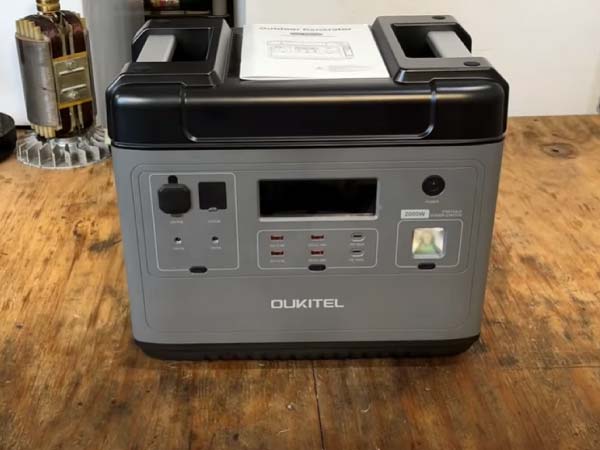
The LCD shows minutes and hours left on the battery instead of percentages which is a big plus. It also shows input and outgoing power, and battery stats.
There is a compartment at the top used for storage. You can store your charging cables in it. 8/10 for design.
One of the main selling points of Oukitel P2001 is the 16 different AC/DC outlets allow us to run multiple things at the same time thanks to the 51V output.
| Ports & Outlets |
|---|
| x6 AC ports = 2000W total. 110V. 60Hz |
| x2 USB-A = 5V 2.5A |
| x2 USB-A = QC3.0-18W |
| x2 USB-C = 5 – 20V/5.0A, 100W |
| x1 XT60 = 12V, 10A |
| x1 cigar lighter = 12V, 10A |
| x2 outputs = 12V 3A |
Oukitel P2001 has multiple charging methods including supercharging using 1100W of AC input from the wall. It will take under 2 hours to charge 100%. You don’t need an extra charging brick, the cable they provide will do the job.
500W of solar input will take around 4 hours on a standard sunny day.
This best solar generator for rv air conditioner has a dual-charging option as well. Using AC charging outlet and both charging jacks, the device can support up to 1600W. It will charge the battery in no time.
The Anderson power pole jack (12 to 48V, 15A) is a perfect different charging method. It also comes in handy during dual-charging.
I also tested the charging form using an inverter generator (Westinghouse Igen4500) that I always carry with me in my RV.
It charged the Oukitel P2001 power station in 1.8 hours using 1100W of input. I disconnected all the load. I was only charging this unit.
You can also charge it using 120/240W 12 10A input from the car outlet.
I conducted two separate load tests. The unit was able to deliver 1977 continuous, and 2200 maximum continuous watts before it shut off. I was running a 1500 heater, and 3 250W heat lamps.
During the inverter efficiency test, Oukitel P2001 constantly delivered 110V AC. The inverter is around 80% efficient which is normal.
Based on my tests, Oukitel P2001 ran the following things in my RV.
| Appliances | Watts or Watt-hours | Time or Charges |
|---|---|---|
| Coffee maker | 600 | 109 CUPS |
| Hair dryer | 1600 | 1.5 to 4.9 hours |
| Laptop | 50Wh | 35 times |
| Microwave | 1000W | 2.2 hours |
| Fridge | 150W | 10 to 24 hours |
| Washer | 500W | 4.2 hours |
| TV | 110W | 15 to 29 hours |
| AC | 1500W | 2.1 hours |
| Mini-fridge | 65W | 36 hours |
| Smartphone | 10Wh | 180 times |
| Camera | 25Wh | 80 times |
| Projector | 100W | 21 hours |
| Drone | 60Wh | 45 times |
One of the main selling points for me was Oukitel’s UPS mode. It pulls the power from the wall bypassing the battery if it is full. If you unplug the wall power, the power will switch on the battery backup in 10 milliseconds.
I tested it, and Oukitel P2001 has a true UPS mode.
Based on my 5-month usage and testing, I found that Oukitel P2001 is a fantastic power station for RV.
It charges up in less than 2 hours, it produces pure sine wave, you can use it while it charges, it has a 13.3V regulated DC output, it has 2 USB-C ports, and an awesome LCD panel.
The only problems I saw were:
- P2001 will shut off if the DC output is less than 2W.
- Some stats on the LCD are accurate.
Here is the full review of Oukitel P2001 2000W
5. Jackery Explorer 1500 Solar Generator for RV
FEATURES & SPECS
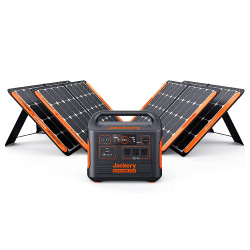
Jackery Explorer 1500 is the elder brother of the explorer 1000 with 50% more battery capacity and 80% more power output. I have used it for Overlanding, car camping, truck camping, and RV for an extended period to gather data for this review.
The thing that impressed me the most is the simplicity and reliability of this product. It is plug-and-play with no fuss.
It offers 1800 running watts and a whopping 3600 surge watts. The battery capacity is 1534Wh. You can power any appliance at 120V.
Out of all Jackery power stations, this Explorer 1500 has the fastest charging (3 to 4 hours).
All the goodies and cables are provided in a quality neoprene bag. The quality and feel of Jackery’s staff are second to none.
The design is the same as other Jackeries. It weighs 15kg which is not heavy at all. Orange stuff on the side is your vents. Rubber feet at the bottom are installed to prevent the unit from slipping.
The dimensions are compact and portable. I haven’t faced any problem so far in terms of space saving.
I like the LCD. It displays battery stats, incoming and outgoing power, and how many hours are left on the device which is always helpful.
The control panel always features physical buttons for AC and DC power. If you want to switch to DC, just press the button and you are good to go.
The only problem I see is the fewer AC and DC outlets. For an expensive unit, they at least should’ve provided more USB-As and Cs.
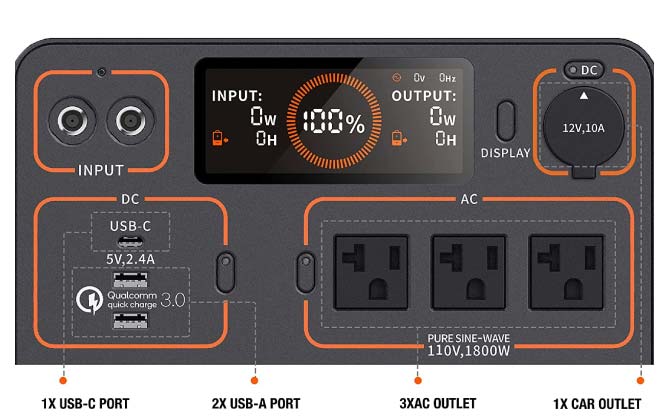
There are 3 charging options. Using two AC bricks, the device can accept as much as 500W to fully charge. It will take around 3.1 to 3.2 hours to fully charge this device.
A lot of people are by thinking that Jackery Explorer 1500 can accept 260W of AC input from their AC charging brick. Actually, you have to use two charging at the same time to get the 500W input.
400W solar input will take 4.1 to 4.2 hours. You can’t use your own panel using an MC4 adapter. You can only use Solarsaga panels which sucks unless you are a DIY guy like me.
From the 12V car port, Jackery 1500 will take around 15 hours to fully charge. This option is only suitable for long road trips. Otherwise, it will take ages to charge it if you are on a road for a day or two.
Before taking it to the road, I conducted a load test. The device gave 1798 running watts after giving it a load of 1500W heater, and 300W heat lamp.
Later, I increase the load to 2000W, Jackery Explorer 1500 was able to provide 1989W before it shut off.
Jackery Explorer 1500 will run the following appliances.
| Appliances | Running Time |
|---|---|
| Mini-cooler | 21.4 hours |
| PS4 console | 63 hours |
| Coffee maker | 71 minutes |
| Electric stove | 67 minutes |
| Microwave Oven | 65 minutes |
| Refrigerator (RV) | 18 hours |
| TV | 22 hours |
So jackery 1500 offers 500 cycles at 80% and it has all the typical safety features. I like that I have been able to power everything under or at 1800 running I wanted it to.
Its performance is solid. Nothing about this unit feels cheap or a pushover. The battery holds the charge pretty, and the BMS doesn’t eat the battery just to stay ON.
Trust me I am a terrible user of these power stations. I abuse them in every possible way. I did the same with my explorer 1500. So far it hasn’t disappointed me.
Here is the full review of Jackery Explorer 1500
How to Choose the Best Solar Generator for an RV?
There are several features you will want to consider before purchasing a power station for an RV, but not all of them are important for outdoor use.
Based on my expertise and experience, the following 5 things should be considered before making a purchasing decision.
1. Battery Capacity:
To make it very simple, the battery capacity of the power station depends on the number of watts required in your RV, and how many hours you are running your appliances.
Suppose you have an LED light that requires 5W to operate and you run it for 6 hours.
5W x 6h= 30Wh
This calculation is extremely important for an outdoorsman so that you don’t fall short in the middle of anywhere. You need to do this calculation for every appliance you are going to run on your solar generator.
Normally, a 1200Wh to 1500Wh battery capacity is considered for travel trailers and RVs, but if you want to replace your 150Ah battery with a solar generator, then the following calculations will help you.
The following devices are most commonly used on a camping trip.
| Device | Amps | Hours | Amp Hours (12v) |
|---|---|---|---|
| Mini-Fridge | 4 | 15 | 60 |
| LED lights | 0.5 | 6 | 3 |
| Phone Charger | 2 | 3 | 6 |
| Laptop | 2 | 7 | 14 |
| Total | 83Ah |
Now consider all the devices in your travel trailer or RV that require 12V.
83Ah x 12V = 996Wh
(V X A= W)
Now add 20% extra to the results because there are always some energy losses taking extra power comes in handy during emergencies. It is a safety precaution.
199.2 + 996 = 1195.2
So there you go. You would require an 1100 to 1200Wh solar generator to replace your 150Ah battery.
If you want to charge your power station using solar power, the following amount of input power from the solar panels is required.
The result we found was 1195.2, now considering 7 hours of daylight.
1195.2Wh/7h = 170W
(Wh/h = W. Hour is canceled into the hour. Watt is the remainder)
Adding 20% extra to the 170. 204W solar panels are required to charge an 1195.2Wh solar generator.
You can play with calculations depending on how much power is required in your RV.
2. Charging Speed:
For outdoorsmen who love to spend most of their time on the road, a fast-charging power station is necessary due to the absence of shore power.
I will not consider AC wall charging from the home’s wall outlet, we will solar charging and car charging outdoors.
Ideally, a good solar generator should charge up to 100% in 4 to 6 hours (available daylight), or at least charge up to 80% so that I can use it throughout the night.
Based on my experience, units that take ages to charge are not preferred by any outdoorsmen. I never take a slow-charging unit in my RV.
I have to charge my camera batteries, drone batteries, cellphone, laptop, LED lights, and a mini-fridge. Most of the time I only rely on the pure sine wave inverter of the power station.
Following are some of the fastest solar charging power stations
- Ecoflow Delta 1300 = 400W solar input, 7.1 hours to fully charge
- Goal Zero Yeti 1000 = 300W solar input, 4.3 hours to fully charge
- Rockpals 600W = 120W solar input, 3.1 hours to fully charge
- Oukitel P2001 = 500W solar input, 4 hours to fully charge
- Jackery 1500 = 400W solar input, 4.2 hours to fully charge
3. Type and Number of Ports:
Although the number and type of ports totally depend on the type and how many appliances you are going to use on the road, based on my experience following.
| Ports and Outlets |
|---|
| x2 to 4 USB-A ports |
| x2 USB-C 100W ports |
| x5 AC output outlets |
| Solar Charging Input |
| One Anderson power port |
| Car outlet |
| AC Charging Input |
It’s what I want in my solar generator. Trust me it comes in handy to have more than a couple of USB-A and USB-C ports if you want to power laptops, LED lights, cellphones, and other 12V appliances.
4. Size and Portability:
Alright, so one of the biggest issues any outdoorsmen faces is how to manage space so that we can carry as much luggage as possible. This statement is especially true for truck camping and car camping.
If you are going to purchase a power station, purchase one that you can easily lift and carry around if it is not sitting in the RV.
Anything that weighs under 35 to 40 pounds is acceptable, but it must have an ergonomic handle so that you can easily carry it as Rockpals and Outkitel has.
Compactness is also important. The unit is portable and sleek and designed with a low center of gravity so that I could fit in tiny spaces.
Fortunately, all the devices on my list are compact and portable.
5. Good BMS:
The reason I haven’t listed Bluetti AC200P despite its futuristic features and power output is the low-quality BMS. It drains the battery just to stay while powering the minimum load through the night.
In cold or hot remote areas, you would want your power station to easily start, charge quickly, and not drain the battery just to stay ON.
That is why I have only listed those devices that have currently the best BMS in the market.

Alex Black is a seasoned electrical engineer with a remarkable 8-year track record specializing in appliances, generators, and transfer switches. With extensive hands-on experience in the field, Alex possesses a deep understanding of electrical systems and their intricate workings. Throughout their career, Alex has consistently demonstrated expertise in designing, troubleshooting, and maintaining various electrical appliances.
